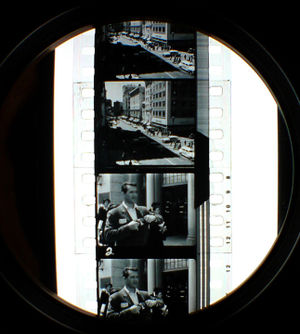| Welcome to Sprocket School! This project is maintained by volunteer editors. Learn more about how this works. |
Sound formats: Difference between revisions
Jump to navigation
Jump to search
No edit summary |
No edit summary |
||
| Line 1: | Line 1: | ||
[[File:Mono tracks.jpg |right|thumb|300px|A print with both variable area and variable density mono tracks.]] | [[File:Mono tracks.jpg |right|thumb|300px|A print with both variable area and variable density mono tracks.]] | ||
'''Sound formats''' are technologies that allow recorded sound to be synchronized to (or otherwise accompany) a film. Before the advent of sound formats, all films were [[silent film|silent]]. | |||
* magenta vs. cyan vs. black/silver/gray for optical tracks | * magenta vs. cyan vs. black/silver/gray for optical tracks | ||
| Line 5: | Line 7: | ||
* Determining sound levels - best practices | * Determining sound levels - best practices | ||
* Sound on disc | * Sound on disc | ||
* optical vs. digital vs. mag | * optical vs. digital vs. mag | ||
* Amplifiers? | * Amplifiers? | ||
Revision as of 21:34, 9 August 2013

Sound formats are technologies that allow recorded sound to be synchronized to (or otherwise accompany) a film. Before the advent of sound formats, all films were silent.
- magenta vs. cyan vs. black/silver/gray for optical tracks
- Determining sound formats (esp. optical formats)
- Determining sound levels - best practices
- Sound on disc
- optical vs. digital vs. mag
- Amplifiers?
- Sound processors
- Speakers
| Sound format | Type | 70mm? | 35mm? | 16mm? | 8mm? | Super8? | Other gauges? | Notes |
|---|---|---|---|---|---|---|---|---|
| Mono | Optical | x | x | variable density vs. variable area | ||||
| Stereo | Optical | x | ||||||
| Dolby SR | Optical | x | ||||||
| Dolby A | Optical | x | ||||||
| Dolby SR-D | Digital | x | Also called Dolby Digital | |||||
| DTS | Digital | x | x | |||||
| SDDS | Digital | x | ||||||
| Magnetic | Magnetic | x | x | x | x | x |